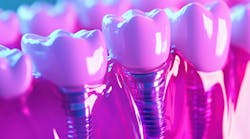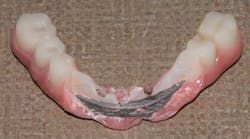Xerostomia: The Invisible Oral Health Condition
By Paula K. Friedman, DDS, MSD, MPH
Xerostomia, or dry mouth, is one of the most underappreciated, underdiagnosed, and undermanaged oral health conditions. Recognition of a xerostomic condition is important because it can significantly affect the overall quality of life and contribute to diminishing oral health in many ways. The following provides an overview of the etiology of xerostomia, the sequelae of the condition, and suggestions for pharmacological and nonpharmacological management of the condition to improve quality of life.
Etiology
Xerostomia is a subjective perception of dry mouth.1,2 Satishchandra3 and Thomson4 have evaluated analogue scale questionnaires as subjective assessments of salivary dysfunction and to provide some basis for comparison of individual patient status over time.
While not a disease itself, xerostomia is symptomatic of many underlying conditions and often associated with diseases such as diabetes, autoimmune conditions, Parkinson's disease, status postcardiovascular accident/stroke, radiation therapy to the head and neck, chemotherapy, and Sjogren 's syndrome. Although often associated with aging, evidence to support aging as an independent variable causative agent for diminished salivary flow is lacking.5-10 Polypharmacy has been clearly linked to the onset of xerostomia, and the number of pharmaceutical agents that have been identified as possible etiological agents is estimated to exceed 500 prescription and over-the-counter drugs. Included in the spectrum of medications that may cause xerostomia are antihypertensives, anticholinergics, diuretics, antidepressants, antipsychotics, laxatives, antihistamines, and dopamines. Other agents that contribute to xerostomia are caffeine, alcohol, tobacco, and carbonated beverages. Additionally, dry mouth can be caused by emotional stress, anxiety disorders, salivary gland disease, endocrine disorders, AIDS, and hormonal changes during menopause.11 Snoring or breathing with an open mouth can contribute to xerostomia as well.
Sequelae
Before discussing the adverse sequelae of the absence of adequate saliva, it is useful to summarize the salutary effects of saliva. Saliva's roles in the oral ecosystem in helping to maintain homeostasis are numerous. Saliva is the first digestive enzyme in the gastrointestinal tract, playing a critical role in the initial breakdown of complex carbohydrates with the enzyme salivary amylase. Saliva is a lubricant, aiding in swallowing and forming a moistened bolus of food during chewing. Saliva cleanses the oral cavity, provides buffering capacity for acids present from exogenous sources (such as foods and beverages) and those created by the microflora in plaque, and facilitates transmission of taste impulses. Saliva also lubricates mucous membranes, protects tissue from minor trauma and ulceration, and serves as a critical luting agent in the retention of removable prostheses. Saliva aids in remineralization of teeth through its calcium ion content. Some investigators believe that saliva may mitigate the deleterious effects of some carcinogens, viruses — including HIV and herpes simplex — toxins, and irritants.12-16
The adverse sequelae that occur in the absence of adequate saliva follow logically. Patients who do not have sufficient saliva are at risk for root caries and opportunistic infections — especially fungal infections such as those caused by Candida albicans. Patients also are at risk for decreased resistance to loss of tooth structure due to attrition, abrasion and erosion.
In the monograph Oral Health in Cancer Therapy,17 the following plethora of adverse sequelae are attributed to loss of salivary function:
• Difficulty with tasting, chewing, and swallowing
• Esophageal dysfunction, including chronic esophagitis
• Nutritional compromises
• Higher frequency of intolerance to medications
• Increased incidence of glossitis, candidiasis, angular cheilitis, halitosis, bacterial sialadenitis
• Loss of oral buffering capacity
• Increased susceptibility to mucosal injury
• Inability to wear dental prostheses
• Markedly increased susceptibility to dental caries
All of the aforementioned have potential to significantly impact the quality of a person's life. Other sequelae may include burning mouth or tongue syndrome.
Clinical management of xerostomia
There are three primary strategies for managing xerostomia: environmental, topical, and systemic.
Environmental management strategies include taking frequent small sips of water (preferably fluoridated water; bottled water does not usually contain 1 ppm fluoride, the accepted therapeutic level; community water supplies vary by community); seeing the dentist regularly and maintaining excellent oral hygiene; avoiding drafts from fans, air conditioners, and the dryness of radiators; using a humidifier at night; and avoiding alcohol, caffeine, and tobacco as they may increase oral dryness. For people who snore, using adhesive strips that open the nasal passages may provide some temporary relief. Some authors caution against the use of alcohol-containing mouthwashes, while others18 found no clinically meaningful differences between alcohol- and nonalcohol-containing mouthwashes in subjective sensations of dry mouth. Included in environmental measures are sucking on sugar-free mints, candy, and lozenges, and chewing sugar-free gum. Carefree® Koolerz gum and Smint® mints contain xylitol that inhibits the growth of the cariogenic Streptococci mutans that causes tooth decay.
Topical management of xerostomia includes the use of commercially available lubricants and salivary substitutes — rinses, sprays, and gels. Some products are available over the counter, while others are available only through dentists (Saliva Substitute®; Omnii BreathTech®; Biotene® products, including chewing gum, toothpaste, mouthwash, and moisturizing gel — Oralbalance® moisturizing gel (also by Laclede); and Oasis® mouthwash and mouth spray are some of the oral moisturizers available. Patient acceptance and preference will determine the most appropriate moisturizing vehicle for individual patients. Patients often must try several products before they find one that works for them. The products require frequent application, so the vehicle of delivery (spray, gel, mouthwash) is a factor in patient preference, as well as product efficacy.
There are two new topically acting prescription products for treating xerostomia — Numoisyn® lozenges and liquid.19
The use of topical fluorides, including fluoride rinses and varnishes, is also an important and useful adjuvant in management of xerostomic patients. If a patient requires a direct restoration, especially for cervical caries, glass ionomer restorations are recommended because of their fluoride-releasing properties.
Systemic management includes the use of prescription sialagogues — parasympathomimetic, muscarinic-cholinergic agonists such as pilocarpine, or a cholinergic agonist that binds muscarinic receptors such as cevimeline. For systemic agents to work, there must be some residual functioning salivary gland. The sialogogues stimulate saliva production, but it may take up to three months for patients to experience maximum benefit. Caution must be taken in prescribing this classification of drug in patients with known cardiovascular disease, controlled asthma, angina pectoris, chronic bronchitis, chronic obstructive pulmonary disease, history of myocardial infarction, nephrolithiasis, or cholelithiasis. Caution should be advised when driving at night or performing hazardous activities in reduced lighting. Both pilocarpine and cevimeline have similar contraindications that include gall bladder disease, narrow-angle glaucoma, acute iritis, uncontrolled asthmas, known sensitivity to the drug, and renal colic (Rankin et al., op. cit.). It is generally advisable to consult with the patient's physician before prescribing these drugs.
Conclusions
Xerostomia affects quality of life in many ways. It makes speech difficult. It makes swallowing difficult. It makes eating some foods difficult. Retention of removable prostheses may become impossible. Xerostomic patients are at risk for caries, attrition, erosion, mucosal irritation, and infections from viral and fungal agents. Dentists are encouraged to query patients about their perception of adequate moisture in their mouths, especially patients on multiple medications and postmenopausal women. Including a question about experiencing dry mouth on the medical history form, such as "Do you feel that your mouth is often dry?" is recommended. There are strategies to address the needs of patients who suffer from xerostomia — environmental, topical, and systemic. Awareness by dentists and allied dental personnel to this invisible oral condition, and offering strategies to patients who suffer from it, may create significant enhancements to quality of life for many.
Additional resources are available through the following American Dental Association Web sites:
There is also a brochure on dry mouth available through the ADA catalog.
References
1 Silverman S, Wilder R. Antimicrobial mouthrinse as part of a comprehensive oral care regimen. J Am Dent Assoc. (supplement). 2006: 22S-26S.
2 Fox PC, Busch KA, Baum BJ. Subjective reports of xerostomia and objective measures of salivary gland performance. J Am Dent Assoc. 1987: 115, 581-584.
3 Satishchandra P, Ghezzi EM, Ship JA. Development of a visual analogue scale questionnaire for subjective assessment of salivary dysfunction. Oral Surg Oral Med Oral Pathol Oral Radiol Endod. 2001: 91, 311-316.
4 Thomson WM, Williams SM. Further testing of the xerostomia inventory. Oral Surg Oral Med Oral Pathol Oral Radiol Endod. 2000: 89, 46-50.
5 Atkinson JC, Wu A. Salivary gland dysfunction: causes, symptoms, treatment. J Am Dent Assoc. 1994: 125, 409-416.
6 Wu AJ, Ship JA. A characterization of major salivary gland flow rates in the presence of medications and systemic diseases. Oral Surg Oral Med Oral Pathol. 1993: 76, 301-306.
7 Ship JA, Nolan N, Puckett S. Longitudinal analysis of parotid and submandibular salivary flow rates in healthy, different aged adults. J Gerontol Med Sci. 1995: 50A, M285-M289.
8 Fisher D, Ship JA. Effect of age on variability of parotid salivary gland flow rates over time. Age Ageing. 1999: 28, 557-561.
9 Baum BJ. Evaluation of stimulated parotid saliva flow rate in different age groups. J Dent Res. 1981: 60, 1292-1296.
10 Heft MW, Baum BJ. Unstimulated and stimulated parotid salivary flow rate in individuals of different ages. J Dent Res. 1984: 63, 1182-1185.
11 For the dental patient. Dealing with dry mouth. J Am Dent Assoc. 2005: 136, 703.
12 Mandel ID. The role of saliva in maintaining oral homeostasis. J Am Dent Assoc. 1989: 119, 298-304.
13 Spolarich AE. Managing the side effects of medications. J Dent Hyg. 2000: 74, 57-69.
14 Heineman HS, Greenberg MS. Cell protective effect of human saliva specific for herpes simplex virus. Arch Oral Biol. 1980: 25, 257-261.
15 Fox PC, Wolff A, Yeh CK, et al. Saliva inhibits HIV-1 infectivity. J Am Dent Assoc. 1988: 116, 635-637.
16 Atkinson JC, Yeh CK, Bermudez D, Fox PC, Baum BJ. Longitudinal evaluation of major salivary gland function in HIV-1 infected patients. J Oral Path Med. 1989: 18, 469-470.
17 Rankin KV, Jones DL, Redding SW (eds.) Oral health in cancer therapy. 2003.
18 Kerr AR, Katz RW, Ship JA. A comparison of the effects of two commercially available non-prescription mouthrinses on salivary flow rates and xerostomia: a pilot study. Quintessence Int (in press, cited in Silverman S, op. cit.)
19 Zunt S. Re-establishing normal salivary flow. Dimen Dent Hyg. 2006: May, 30-32.
Paula K. Friedman, DDS, MSD, MPH, is a director of geriatric dentistry, professor, and associate dean for administration at Boston University School of Dental Medicine. E-mail her at [email protected].

